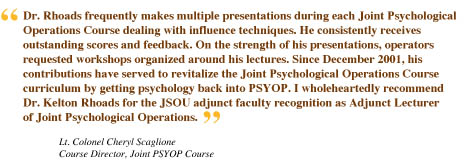

  |
|
Dr. Rhoads speaks extensively throughout the United States. If you're interested in having Rhoads speak to your group, please contact Working Psychology. Descriptions of five popular presentations follow:
Influencing Hostile Audiences Hostile audiences don't agree with you, they're suspicious of your motives, they challenge your statements. They may view your group negatively, may have had bad experiences with your products and services, or may dislike what you stand for. As audiences become increasingly politicized, tribalized, organized, and vocal, the need for effective persuasion becomes acute. Influencing Hostile Audiences is one of Rhoads' most frequently requested presentations. It outlines seven culture-spanning tactics that work effectively even with difficult-to-persuade groups. The presentation examines when to use which tactics, and provides evidence of their effectiveness for audiences who are opposed to the communicator. Participants learn:
 Influencing the Legislator Upward influence is difficult! Especially when you're trying to persuade busy, powerful lawmakers to support your cause. This presentation is for political and grassroots activists who need to influence their legislators. It covers:
This presentation is usually delivered in conjunction with Amy Showalter of The Showalter Group, whose firm specializes in grassroots and PAC organization, communication, and effectiveness.
 10 Influence Campaign Errors This is a social scientist’s view of where things usually go wrong in influence campaigns. This presentation is particularly useful for political professionals, grassroots activists, social-action experts, and others who execute campaigns that must persuade large numbers of people to change their behavior. It examines:
This is a fast-paced presentation that moves quickly from topic to topic, providing more breadth than depth.
Framing: the Pre-persuasion Battleground One of Rhoads’ most popular presentations. Much of influence is accomplished through “pre-persuasion” techniques, which include the framing of a debate before the debate itself begins. A good frame makes successful influence much more "invisible." Being able to choose the correct frame is like a battlefield commander who is able to choose the time and location of an attack, with all the advantages that such control affords. Attention is paid to real-world framing battles, types of frames, reframes, and frame construction. Examples range from Michael Moore to OJ Simpson to Rush Limbaugh, and a framing checklist concludes the presentation. Vital information for waging mass-media based campaigns, but also useful for interpersonal influence. Workshop versions of this presentation (see Workshops) include framing exercises and the administration of a values inventory. (You can sample some of the content of this presentation at the academic: framing portion of this website, but the presentation does not follow the website closely. The presentation is less academic and more applied.)
 Narrative: Influence Stealth Technology Are your employees or members able to tell compelling stories that promote your cause? Recent research has shown that stories are strongly persuasive. However, people are much less likely to recognize narratives as an attempt to persuade, making stories an effective “stealth technology” of influence. The use of narrative is appropriate for situations where overt advocacy would be inappropriate or rejected out of hand by a hostile audience. This presentation explains why and how narrative works to persuade below the level of conscious awareness. Startling examples of the persuasiveness of known fiction is presented. This module ends with suggestions on how to create narrative themes for persuasive effect. In workshop form, exercises encourage participants to create compelling stories for their advocacy. This module attains a high level of audience response. Appropriate for all audiences.
Custom Presentations
Custom Presentations may be arranged for a variety of influence disciplines:
Please contact Working Psychology for further information. Clients may request a Quicktime video clip sampler on CD-ROM for previewing...
www.workingpsychology.com All rights reserved.  |